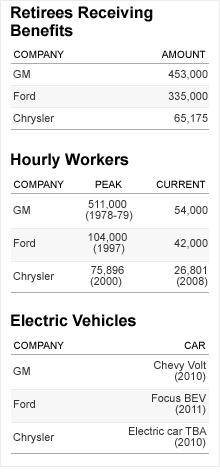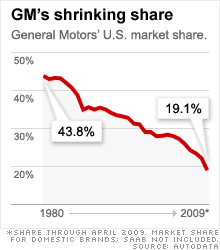GM bankruptcy: End of an era
After years of losses, the troubled automaker is forced into bankruptcy. GM is set to close a dozen facilities and cut more than 20,000 jobs.


NEW YORK (CNNMoney.com) -- General Motors filed for bankruptcy protection early Monday, a move once viewed as unthinkable that became inevitable after years of losses and market share declines capped by a dramatic plunge in sales in recent months.
The bankruptcy is likely to lead to major changes and job cuts at the battered automaker. But President Obama and GM CEO Fritz Henderson both promised that a more viable GM will emerge from bankruptcy.
In the end, even $19.4 billion in federal help wasn't enough to keep the nation's largest automaker out of bankruptcy. The government will pour another $30 billion into GM to fund operations during its reorganization.
U.S. Judge Robert Gerber, the bankruptcy judge will oversee GM's bankruptcy, ruled Monday that GM will have access to $15 billion in government funds immediately. He will make a final ruling on bankruptcy financing approval on June 25.
Taxpayers will end up with a 60% stake in GM, with the union, its creditors and federal and provincial governments in Canada owning the remainder of the company.
Owners of GM cars should see little change as a result of the bankruptcy since warranties will still be honored. But there will be plenty of pain caused by the bankruptcy and the company's efforts to stem losses.
GM will shed its Pontiac, Saturn, Hummer and Saab brands and cut loose more than 2,000 of its 6,000 U.S. dealerships by next year. That could result in more than 100,000 additional job losses if those dealerships are forced to close.
A dozen facilities were identified for closure. Those plants employ most of the more than 20,000 U.S. workers GM intends to cut by the end of next year.
Assembly lines at a plant in Pontiac, Mich., which make full-size pickup trucks, will be closed later this year. A Wilmington, Del.-based facility that makes roadsters for the Pontiac and Saturn brands will also close later this year.
Three parts distribution warehouses are set to close at the end of this year, while five engine plants and a stamping plant are due to close in 2010. An additional stamping plant is set to close in 2011.
Three more plants. including assembly lines in Spring Hill, Tenn., and Orion, Mich.,are set to be idled and put on stand by status in hopes for a rebound in sales that may never come.
More than 650,000 retirees and their family members who depend on the company for health insurance will experience cutbacks in their coverage, although their pension benefits are unaffected for now.
Investors in $27 billion worth of GM bonds, including mutual funds and thousands of individual investors, will end up with new stock in a reorganized GM worth a fraction of their original investment.
Owners of current GM (GM, Fortune 500) shares, which closed at just 75 cents a share on Friday, will have their investments essentially wiped out.
Officials from the Obama administration and the United Auto Workers union both have said they hope to sell their stakes in GM as soon as possible, but it is likely that shares of the new GM will not be publicly traded for at least a year or two.
The bankruptcy filing led the New York Stock Exchange to announce it would no longer list GM shares after Monday.
It will also lead to the removal of GM as of June 8 from the Dow Jones industrial average, a distinction it has held since 1925. The company will be replaced in the Dow by technology giant Cisco Systems (CSCO, Fortune 500), Dow Jones said.
President Obama said Monday he was confident that the additional federal help was justified by the changes being made at GM.
"GM and its stakeholders have produced a viable, achievable plan that will give this iconic American company a chance to rise again," he said.
"But GM can't put this plan into effect on its own. Executing this plan will require a substantial amount of money that only a government can provide."
Henderson, who took over for former CEO Rick Wagoner on March 30, will continue running the company. Henderson thanked Obama as well as the unions and creditors who had agreed to changes.
He vowed the company will not need additional help from the government beyond what it will receive during the bankruptcy process and added that the part of GM that emerges from bankruptcy will not be at risk of failure in the future.
"We understand there are no second chances," he said. "We won't need one."
GM and the Treasury Department were able to get key concessions from the unions and major bondholders in the past two weeks. Those deals paved the way for a cleaner bankruptcy process, one that a senior administration official said Sunday could allow GM to emerge from the bankruptcy process in only two to three months.
GM faced a deadline from the Treasury Department to come up with a plan to turnaround the company or file for bankruptcy by June 1. The company also owed its bondholders $1 billion in interest payments on June 1, money it did not have available to pay.
According to GM's bankruptcy filing , the company has assets of $82.3 billion, and liabilities of $172.8 billion. That would make GM the fourth largest U.S. bankruptcy on record, according to Bankruptcydata.com, just behind the 2002 bankruptcy of telecom WorldCom.
Three of the largest bankruptcies in history - GM, Wall Street investment bank Lehman Brothers and savings and loan Washington Mutual, have occurred in the last nine months.
GM will use the trip into bankruptcy court to shed plants, dealerships, debt and other liabilities it can no longer afford. Emerging out of bankruptcy quickly will be a "new GM," made up of the four brands that GM will keep in the U.S. market -- Chevrolet, Cadillac, GMC and Buick -- as well as many of its more successful overseas operations.
This is the same process that Chrysler LLC used in its bankruptcy process. Chrysler filed for bankruptcy April 30, and the judge in that case approved the creation of a new company that will be run by Italian automaker Fiat in a ruling Sunday.
GM, being a larger, more complicated and global company than Chrysler, is not expected to have its valuable units exit bankruptcy quite as quickly, though.
The new GM will have only $17 billion in debt, rather than the $54.4 billion it owed as of March 31. The unions' new contracts with the company and GM's underfunded pension funds will stay with the new company.
But for the turnaround to be successful, both outside experts and company officials agree there needs to be improvement in U.S. auto sales, which have fallen to a 26-year low this year.
GM has been hit harder than most of its competitors during the sales slump. The company's U.S. sales through April were down 45% from a year ago, compared to a 37% decline for the overall industry.
GM also faces tough competition from Toyota Motor (TM) and Ford Motor (F, Fortune 500), which are both in much stronger financial condition.
Even though Ford has reported years of losses as well, it had far more cash on hand than GM or Chrysler going into this crisis. The same is true for Toyota, which reported a loss in its recently completed fiscal year.
GM's decision to shed its weaker brands and dealers is expected to lead to further market share losses, which could result in the company giving up its long-time position as the largest automaker in terms of U.S. sales.
The company already lost the global sales title to Toyota last year, and it could soon fall behind Toyota and possibly Ford in the U.S. as well. ![]()


